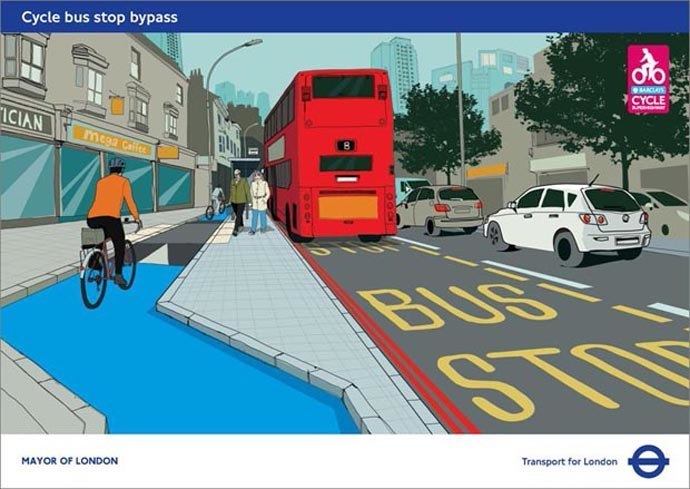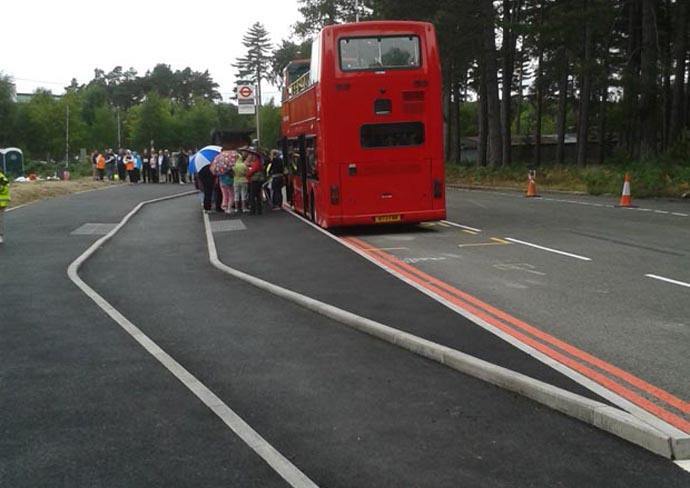
A new design of bus stop bypass is receiving a mixed reception. Whitechapel High Street is the first busy street in London on which bicycles are diverted around the back of newly installed bus stops. Cyclists pass between the pavement and those getting on and off the bus.
According to Labour councillor and blogger, Vincent Stops, ‘these so-called bus stop bypasses are designed to facilitate high speed cycling with cycle priority, so that cyclists do not need to slow down, nor need to overtake a bus which has paused to pick up passengers. Visually impaired pedestrians and passengers will be most disadvantaged…Boarding and alighting the bus now means dodging cycles travelling at speed around the back of bus stops.’

In theory, and below, in practice
Stops’s argument is that the bus stop bypass is an example of cycling facilities aimed squarely at high-speed commuters; infrastructure that runs counter to the concept of urbanism and its promotion of ‘place’ over simply movement.
Stops may over-state his argument on his blog, but when we were invited to the Transport Research Laboratory to see the prototype bus bypass in action, we too had reservations about how it would work on a busy urban street.
Bus stop bypass
Faced with an increasing number of cyclist fatalities on the roads of London, the mayor commissioned the development of improvements to the capital’s roads in a bid to make them safer for those on two wheels.
Tasked with assessing the various ideas, which range from Dutch-style roundabouts to cycling-specific traffic lights, was the Transport Research Laboratory (TRL); a 90-year-old establishment in Berkshire that specialises in all aspects of ‘Transportation, Safety, Vehicles, Environment, Sustainability and Transport Infrastructure’.
So wide is its remit and so extensive its expertise, that its facilities help train police high-speed pursuit drivers and, during the war, helped in the development of the bouncing bomb. Indeed, the place feels not unlike a military installation; acre upon acre of mature pine forest crisscrossed by long, straight and empty roads.
We spent a day at TRL two years ago to help test a bus stop bypass.
I was part of a group of 120 volunteers, 20 of whom were on bikes. When I first encountered the freshly-built, full-size recreation of the bus stop bypass, it was hard not to imagine the design causing some degree of conflict between pedestrians and cyclists; an engineered pinch point between bicycles in a hurry and people being disgorged from the bus during rush hour.
My preconceptions set to one side and a participant number emblazoned on my chest, I spent the day being asked to move from the footway to the bus stop, from the bus stop to the bus and from the bus to the footway. And so it continued. Over and over again. Sometimes I was one of only two people. Occasionally, and in an attempt to recreate rush hour, the group was much larger.
After each movement, we were asked to score out of ten how easy and safe we had found it.
Rigorous testing often involves seemingly endless repetition of this kind, but under such controlled surroundings it was difficult for any of the volunteers to score any less than a nine or perfect ten.
The problem is that the environment was entirely removed from reality. Not only did the freshly-laid asphalt, immaculate woodland and absence of any traffic look like a stylized architectural sketch, but we volunteers had to conform to a rigorous set of criteria ourselves. The testing purposefully involves no children, no buggies, no people using iPods, no wheelchairs, no one on a mobile phone or stray shopping trolleys. In other words, as far from a London street as it’s possible to get. As an attempt to assess the performance in real-world conditions it fell well short.
The ethical choice
The ETA was established in 1990 as an ethical provider of green, reliable travel services. Over 30 years on, we continue to offer cycle insurance , breakdown cover and mobility scooter insurance while putting concern for the environment at the heart of all we do.
The Good Shopping Guide judges us to be the UK’s most ethical provider.


Gianluca
Unfortunately London is not safe for anyone: cyclists, pedestrians and drivers. Drivers are protected by a shell so they are luckier than the others. I cycle everyday, in any weather condition, from one side to the other side of London and my experience is London is not designed for bicycles and some blue paint on the street doesn’t make it any different. The main problem is EDUCATION, which something missing in any of the groups about. Everyone thinks is the only one on the street and everyone does what his own things not paying attention that we share the space. I lived in the Netherlands and the system works there because EVERYONE is a cyclist, which means everyone knows what it means when you a truck overtaking you. London is far from being like the Netherlands, unfortunately. The video you posted here about Whitechapel road has things missing: trolley from the supermarket parked on the cycle path in the morning, all kinds of rubbish, drain covers, manhole covers. Then they just finished part of it and all bumps. It’s far from being smooth as it is supposed to be. So it’s impossible to cycle that fast. And if you don’t trust me, please, have a ride from the City to Stratford and then we can talk.
And another thing… Cyclists are dangerous, for sure. But does anyone pay attention on what pedestrians do? Texting while crossing the street, wearing headphones playing music, crossing the street without paying attention. They get angry. Could somebody explain them how dangerous they are? Could we make a law where no one on the street can be completely isolated with their own music? You, pedestrian, live in a city with other people, you share it with others and you cannot do what you want. If you think you are this is not true or fair move in the desert.
david sproxton
This is a design seen on the Continent and I have seen it in Berlin where it works well. I think the big difference is that cyclists in Germany tend not to be so fast moving, heads down sort of cyclist we see in London where speed seems to an obsession. . The Germans are mostly on uprights, wearing everyday clothes and mostly without helmets. In other words they have a more social approach to travelling by bike around towns. And thus this design works very well.
Maurice Hopper
Would seem science is at about the same level as VW. The lab test clearly has little contact with reality.
What we need is strong pro-pedestrian origanisation in this country to stop this sort of nonsense before it get out of hand.
Pete
This works all over Holland! The difference is that fast cyclists are on the road with the cars and normal cyclists in everyday clothes on the track, giving way to each other as necessary.